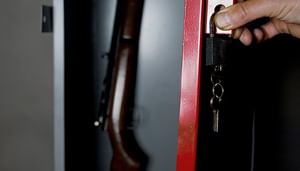How to talk with parents about access to a firearm when in crisis
When a child or teen is in crisis, it’s critical that they cannot access a firearm, because they may be at risk of harming themselves or others. It may not always be clear to parents when their child is struggling. it’s important for health care professionals to have open and honest conversations about reducing access to dangerous materials like firearms that can be used to harm themselves or others. Reducing access to lethal means—a term used to describe removing anything that can be used to attempt suicide (like firearms, medications, sharp objects)—can help people in crisis stay safe.
Health care professionals can help reduce firearm injuries and deaths among children and teens by talking with parents about secure firearm storage and screening for depression, anxiety, and self-harm.
When to talk about firearm access

These conversations are most urgent when a parent or child mentions that they or someone in their household is experiencing severe depression with suicidal ideation, high stress, increased isolation, behavioral changes, or other mental health struggles. But a suicide attempt or intentional shooting is often an impulsive decision, and anything that delays or prevents access to a gun can be lifesaving. Secure firearm storage is a proactive way to keep children, teens, and families safe from harm.
Storing firearms securely can also protect others who spend time in your home. If you have an unsecured firearm in your home and you have young relatives or your child has friends over, any of those children and youth could find and use the firearm to hurt themselves or someone else.
Research underscores the strong connection between unsecured firearms and the increased risk that a child will harm themselves or others. In 75% of youth firearm suicides for which the gun storage method could be identified, the gun was stored loaded and unlocked. Additionally, 76% of youth less than 18 years of age who were involved in a school shooting used a gun they accessed from the home of family or friends. Research has illustrated that young brains continue to mature and develop into the mid-twenties. In particular, the frontal lobes of the brain, which are responsible for decision making and understanding future consequences, are not fully developed until early adulthood. Proactive secure firearm storage decreases unauthorized access to guns and helps keep kids and families safe.
How to start the conversation
You can address the topic of firearm access while discussing other common safety issues among young people. When discussing with parents of a teen patient you may ask if the teen is learning to drive, smokes or vapes, or wears a bike helmet. Then move onto firearm injury prevention conversations in the context of keeping young people safe.
“I care about your child’s health and safety. Is it OK if I ask a few routine questions about common safety concerns?”
“How do you store the firearms in your home? If your child were in crisis, how would you prevent them from accessing a firearm?”
“Could I share a handout with you on best practices for secure firearm storage when there are kids in your home?”
How to talk about secure firearm storage

If a patient or their parent/caregiver shares that there are unsecured firearms at home, they may not have considered the potential risks when someone is in crisis. Young people sometimes have strong emotional responses to life changes, such as a relationship breakup or other significant events like not getting on the varsity team, and they may consider harming themselves or others. A moment of crisis can lead to an impulsive action with devastating results.
Young children have difficulty assessing risk. Adolescents may be prone to risk-taking behavior and acting impulsively. When adolescents use alcohol/drugs and have access to a gun, the risk for violence increases. These developmental considerations make access to guns particularly dangerous for children and adolescents.
You may hear patients or their parents express the belief that hunting rifles and shotguns can’t be used in a suicide. But that is not true. One multi-state study found that long guns were used in nearly a third of firearm suicides—and they were disproportionately used by young people (Source: National Library of Medicine).
Talking with parents about secure firearm storage normalizes these conversations as being part of a discussion about safety and raises their awareness of the potential risks.
“It seems like things are going well, and that’s great. But it’s possible that your child could experience something that sparks a crisis. In that moment, having access to a firearm could be lethal to them or even someone else.”
"Securing all of your firearms helps prevent unauthorized access."
“Anyone can experience a moment of crisis, so it’s important to put time and space between a person in crisis and a firearm. Storing all firearms securely is a straightforward way to keep loved ones and your community safe.”
How to talk about firearms and risk of harm
When a young person is in crisis and seeks medical help, it becomes even more important to talk about reducing access to lethal means, especially firearms. Secure firearm storage can put time and space between a person in crisis and firearms to help prevent harm. When a young person is in crisis, access to a firearm can turn into a permanent tragedy.
Research shows that youth suicide attempts are often impulsive, which means any barriers to accessing lethal means can prevent a permanent tragedy. Firearm suicides are fatal 90% of the time (Source: ACP Journals). Compare that to other means of suicide, such as attempted medicinal overdose, where the survival rate is 95% (Source: JAMA Network).
As a health care professional, you can prepare for these conversations by familiarizing yourself with knowing the warning signs, secure firearm storage methods, temporary off-site firearm storage facilities in your community, and the local, state and federal firearm laws.
Talking with parents about how to recognize the signs that someone may be in crisis equips them to make informed choices about their family’s safety.
“If your child’s behavior changes, and they seem angry, aggressive, or more isolated, they may be at risk of hurting themselves or others. The warning signs can be hard to recognize, so it’s urgent to make sure they don’t have access to a firearm.”
“Suicidal impulses are usually temporary and involve little planning. Reducing someone’s access to firearms while they are in crisis can add time and space for them to “cool down.” Then the impulse will pass which will keep them alive.”
"Have you considered additional methods to secure your firearms to prevent unauthorized access? Locking firearms with a cable lock is an easy first step, while lock boxes or safes may provide more protection. Unloading your firearms and storing ammunition separately adds another layer of protection to ensure your loved ones stay safe."
While the focus of this guide is on parents and caregivers having conversations regarding the youth and teens in their life, if you are concerned that there’s an imminent risk the adult patient or someone close to them over the age of 18, will harm themselves or others, consider talking with the patient about a voluntary, temporary surrender of a firearm to authorized parties. Laws around firearm surrendering – whether temporary or permanent – vary based on state and locality, so it may be helpful to direct your patient’s parent or caregiver to their local law enforcement or public health agency for more information.
After the chat
- Share after-visit summary resources including secure firearm storage best practices.
- If a patient asks questions you aren’t sure how to answer, let them know you will try to find answers and get back to them. For example, they may want more details about secure firearm storage options or statistics about firearm-related injuries and young people. Check our resources page to learn more.
Tips for having productive conversations
- Focus on finding common ground about health and safety with patients and their parents. Ultimately, you both want the child to live a safe, healthy life.
- Familiarize yourself with local and national resources so that you can share them with patients. For example, many local nonprofits and police departments offer free firearm locks.
- Acknowledge if you do not have all the answers about firearms laws in your area. Reach out to local law enforcement or public health agencies to understand your state’s firearm regulations and resources, especially those surrounding voluntary and/or temporary firearm surrender.
- If a patient, parent, or family member isn’t interested in discussing firearm safety with you, respect that decision. Focus on building trust, and revisit the topic during a future visit.
The information provided on this site is for general education purposes. Consult your health care professional for specific advice. Call or text 988 if you or a loved one is in crisis.
Start a conversation
The resources available on our site are provided for informational purposes only and do not necessarily reflect the views or positions of the American Medical Association (AMA) or the Advertising Council, Inc.
